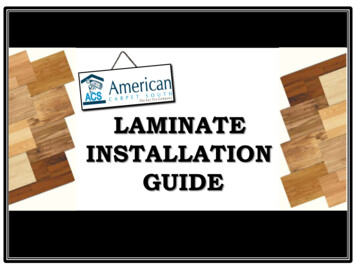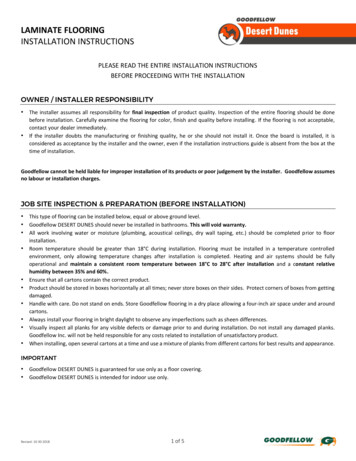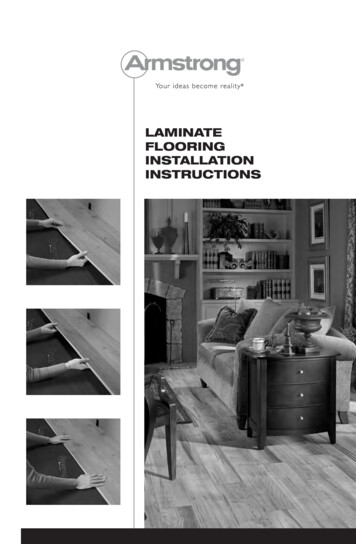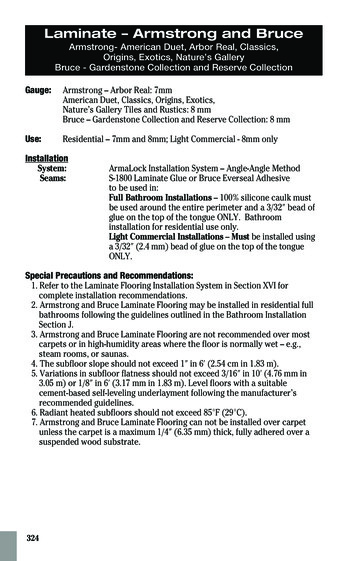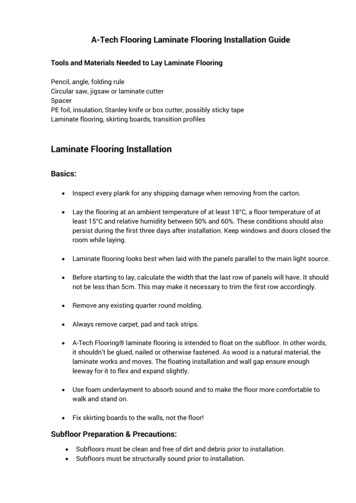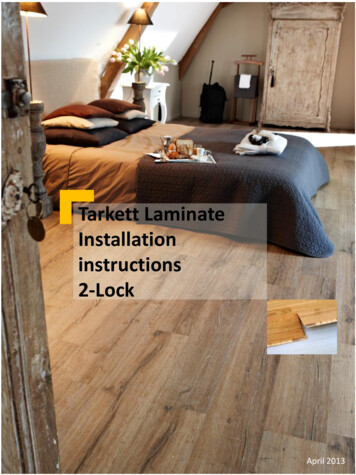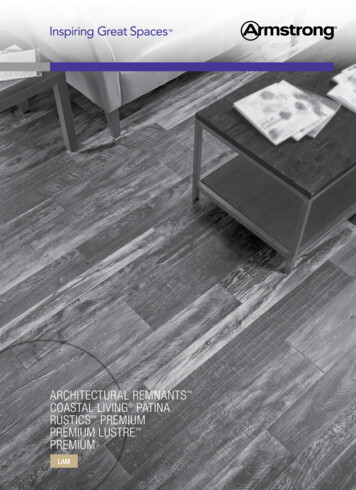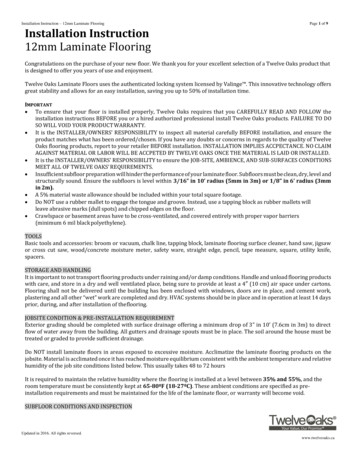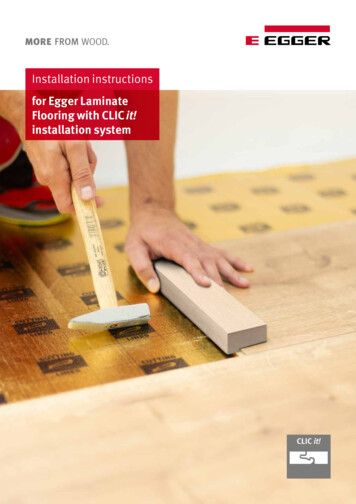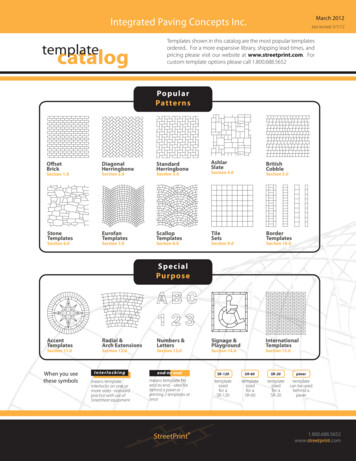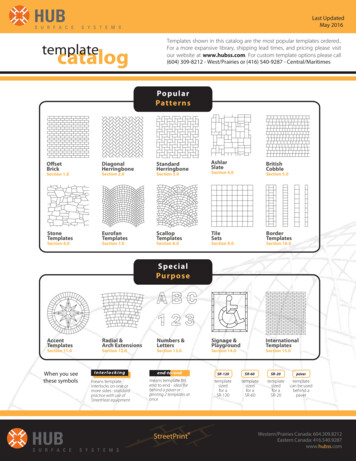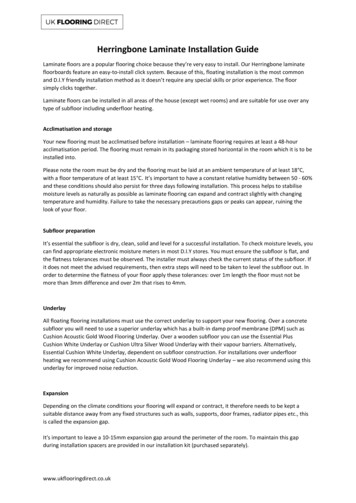
Transcription
Herringbone Laminate Installation GuideLaminate floors are a popular flooring choice because they’re very easy to install. Our Herringbone laminatefloorboards feature an easy-to-install click system. Because of this, floating installation is the most commonand D.I.Y friendly installation method as it doesn’t require any special skills or prior experience. The floorsimply clicks together.Laminate floors can be installed in all areas of the house (except wet rooms) and are suitable for use over anytype of subfloor including underfloor heating.Acclimatisation and storageYour new flooring must be acclimatised before installation – laminate flooring requires at least a 48-houracclimatisation period. The flooring must remain in its packaging stored horizontal in the room which it is to beinstalled into.Please note the room must be dry and the flooring must be laid at an ambient temperature of at least 18 C,with a floor temperature of at least 15 C. It’s important to have a constant relative humidity between 50 - 60%and these conditions should also persist for three days following installation. This process helps to stabilisemoisture levels as naturally as possible as laminate flooring can expand and contract slightly with changingtemperature and humidity. Failure to take the necessary precautions gaps or peaks can appear, ruining thelook of your floor.Subfloor preparationIt’s essential the subfloor is dry, clean, solid and level for a successful installation. To check moisture levels, youcan find appropriate electronic moisture meters in most D.I.Y stores. You must ensure the subfloor is flat, andthe flatness tolerances must be observed. The installer must always check the current status of the subfloor. Ifit does not meet the advised requirements, then extra steps will need to be taken to level the subfloor out. Inorder to determine the flatness of your floor apply these tolerances: over 1m length the floor must not bemore than 3mm difference and over 2m that rises to 4mm.UnderlayAll floating flooring installations must use the correct underlay to support your new flooring. Over a concretesubfloor you will need to use a superior underlay which has a built-in damp proof membrane (DPM) such asCushion Acoustic Gold Wood Flooring Underlay. Over a wooden subfloor you can use the Essential PlusCushion White Underlay or Cushion Ultra Silver Wood Underlay with their vapour barriers. Alternatively,Essential Cushion White Underlay, dependent on subfloor construction. For installations over underfloorheating we recommend using Cushion Acoustic Gold Wood Flooring Underlay – we also recommend using thisunderlay for improved noise reduction.ExpansionDepending on the climate conditions your flooring will expand or contract, it therefore needs to be kept asuitable distance away from any fixed structures such as walls, supports, door frames, radiator pipes etc., thisis called the expansion gap.It's important to leave a 10-15mm expansion gap around the perimeter of the room. To maintain this gapduring installation spacers are provided in our installation kit (purchased separately).www.ukflooringdirect.co.uk
After you have installed the floor you can cover this expansion gap with scotia beading or replace you oldskirting boards with new ones, this gives a much more professional finish. An expansion gap also needs to beleft in doorways where the floor follows through from one room to another or not. We have a full range ofdoor profiles available to match your floor.Please note the following: There's little colour variation within laminate, however we still recommend opening a minimum of 3packs, to mix up the grain pattern and any shade variation.All flooring will chip and scratch unless care is taken to protect it, felt pads should be used on allmoveable furniture. Matting at room entrances will greatly reduce grit and dirt from beingtransferred onto your flooring.Liability for the installation remains with the installer following the fitting instructions and guidessupplied.Click together installationBefore you begin your installation, we recommend that you sort the planks into two piles (Aand B). To help you, the planks have A or B on the base.A plank of each type will be required to create the classic Herringbone Pattern. Each unit ofHerringbone flooring comes with an equal number of planks, a right-handed plank and aleft-handed plank will be required to form a joint.Each board is designed with a click profile on all four sides to join the boards together.Simply insert the long side tongue into the groove at a medium angle and then push themdown. The shorter end, known as the “Header Joint”, will vary dependent on productchosen.www.ukflooringdirect.co.uk
Take two B planks and three Aplanks. Click the first B plank intothe Header Joint of the first Aplank. This will form a V shape.Take the second A plank andplace it to the right of your Vshape and click it in place.Take the second B plank, placeit to the left of your V shape andclick it in place. Take the third Aplank, place it to the right of yourV shape and click in place.Take a fourth A plank and clickthe header joint in place to thesecond B plank.Mark a straight line from the topright corner of the third A plankto the top right corner of thefourth A plank and cut.You’re left with an invertedtriangle. Disconnect the boards,glue, and stick back together,making your shape more sturdy.Starting from the centre of therear wall and working outwards,place your inverted triangles.Make sure there’s a 10mm gap atthe back and side wallsTo fit the last inverted trianglesagainst the left and right-handwall, first measure the distance(a). Make sure your measurementstops 10mm short of the wall.For the left-hand wall, takedistance (a), mark (right-to-left)on the inverted triangle and cut.For the right-hand wall mark(left -to-right) and cut.
Now cut, your last two invertedtriangles will slot nicely into place.For your first row work fromright- to-left. Place B planks tothe left of each inverted triangleand click them into place.For the last plank, take ameasurement (a) and mark it onyour B plank.Cut measurement (a) at a45o angle so it fits within theremaining space.Glue the board to the invertedtriangle to make sure it’s sturdy.For your next row work fromleft-to-right. Place A planks to theright of each inverted triangleand click them into place.Continue working down, usingB planks from right-to-left and Aplanks from left-to-right, applyingthe same methods as above.
Installation over Underfloor Heating SystemsThere are many types and manufacturers of water piped underfloor heating systems, so please ensure that thesuitability and recommendations of the manufacturer of your system are sought and adhered to BEFOREcommencing installation of your engineered flooring.DO NOT install Herringbone flooring over any form of electrical matt UFH system.Important: The above is a brief guideline on the installation of our laminate flooring; please always refer to themanufacturer’s installation guidelines contained within packs of the flooring.If you require any further advice on installation then please call our Flooring Experts on 02476 012 840, email us at technical@ukflooringdirect.co.uk or click the Live Help button at the top of the page.www.ukflooringdirect.co.uk
Laminate floors are a popular flooring choice because they're very easy to install. Our Herringbone laminate floorboards feature an easy-to-install click system. Because of this, floating installation is the most common and D.I.Y friendly installation method as it doesn't require any special skills or prior experience. The floor
